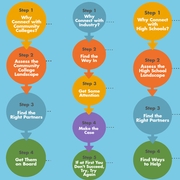Preparing Students for Information Technology Careers: The Role of Career Technical Education
By Jill Denner, PhD | November 28, 2016
Senior Research Scientist, ETR
Vocational education is making a comeback! Nationally, we are seeing new attention being brought to career-technical education (CTE). Revitalized efforts are seeking to provide students the mix of technical training and academics that will prepare them for real-world, 21st century careers. We expect this trend to continue. In fact, the House of Representatives recently passed legislation to provide support for expanded CTE efforts.
Computer science skills—including the ability to code—play a role in a number of the established CTE pathways. This would be true, for example, in business and finance, education, health science, information technology, and manufacturing and engineering.
ETR is nationally known for our interdisciplinary research, evaluation and program strategies aiming to increase equity and inclusion in the information technology (IT) world. Our recent research sheds light on some of the challenges—and potential solutions—to boosting the pipeline to technology careers for underrepresented populations (for example, females, Latinos, African-Americans). We believe this work is an essential component of our nation’s efforts to build an emerging workforce that is competent and prepared.
Some Questions
One of our current projects, called “Stealth Recruitment,” is specifically designed to explore ways to build career technical education pathways in IT fields for rural high school students from underrepresented groups. This work is led by Research Associate Eloy Ortiz and funded by a grant from the National Science Foundation (1400654). In partnership with Regional Occupational Programs in Santa Cruz and Salinas, the project tests two key strategies.
The first is to build strong, sustainable partnerships across high schools, community colleges and employers. In most communities, these stakeholders do not naturally communicate with each other in their day-to-day jobs. They lack resources for building those partnerships.
The second strategy is to infuse technology learning, such as coding, into digital media classes, like graphic design. This “stealth” approach mirrors what others have done in college and makes a unique contribution to a a larger discussion about how to offer coding for all students.
The logic behind this approach is that students in digital media classes such as graphic design and digital photography are often using computational thinking strategies, such as formulating and solving problems and representing data through abstractions. These are the same strategies seen in computer science classes, but digital media students are not being encouraged to consider information technology courses and careers within their classes.
Some Answers
One of the findings from this project is that there is often a great interest on the part of K-12 educators and administrators and community college faculty to collaborate with each other and with their local tech industry. But people on both the K-12 and CC sides are unsure of how to initiate those partnerships—how to find the right person to talk to and how to approach them. Our Stealth Recruitment project has produced three Tip Sheets designed to help people initiate partnerships and enhance pathways to tech education and careers.
Another finding is that students in Digital Media classes are interested in learning to code, and their teachers would like to integrate those skills and concepts into their classes and tell their students about IT careers. However, most Digital Media teachers do not have the time or background to teach coding. Neither do they have the industry connections to bring in guest speakers or create internship opportunities.
Another product from the Stealth Recruitment project was the creation of a set of modules and curriculum steps that introduce coding activities, and then help students connect these to their digital media classes. The activities drew from free websites, such as Intro to JavaScript: Drawing & Animation at Khan Academy, JavaScript and image editing at Vidcode, and game programming and design at Microsoft Touch Develop.
Commitment Makes the Difference
We are excited about the partnerships we have made with teachers and administrators who are committed to students in career technical education classes. Many others have simply written off these students from the traditional pathway to a four-year computer science degree. We advocate for greater attention to ways we can create opportunities for less traditional students. We want them to make their own choices about whether they want to pursue a career that involves coding or other computer science or Information Technology-related activities.
Although we have only taken a small step, we believe that a “stealth recruitment” strategy has great potential for helping to increase diversity in tech fields, especially when paired with strong and sustainable partnerships that build pathways from high school to college and career.
Jill Denner is a Senior Research Scientist at ETR. She does research and evaluation with a focus on increasing diversity in STEM fields. She can be reached at jilld@etr.org.





